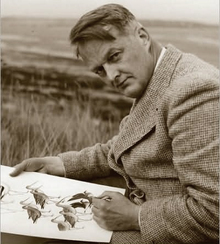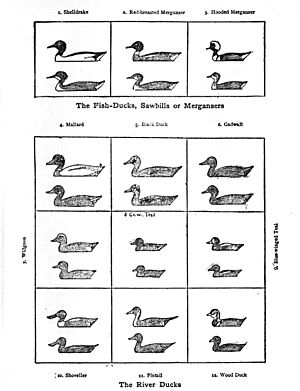Roger Tory Peterson facts for kids
Quick facts for kids
Roger Tory Peterson
|
|
|---|---|
 |
|
| Born | August 28, 1908 Jamestown, New York |
| Died | July 28, 1996 (aged 87) Old Lyme, Connecticut |
| Occupation | author, illustrator, naturalist, ornithologist |
| Nationality | American |
| Subject | Birds |
| Notable works | Wild America, The Peterson Field Guides |
Roger Tory Peterson (born August 28, 1908 – died July 28, 1996) was an amazing American naturalist and conservationist. He loved studying nature, especially birds. Roger was also a talented artist and illustrator. He taught many people about the natural world. He helped start the modern environmental movement in the 20th century. Many people were inspired by his work.
Contents
Early Life and Education
Roger Tory Peterson was born in Jamestown, New York, on August 28, 1908. Jamestown was a small factory town in western New York. His father, Charles Gustav Peterson, came from Sweden. His mother, Henrietta Badar, came from Germany and Poland. She was a teacher.
When Roger was in high school, one of his teachers, Miss Hornbeck, encouraged him. She saw his interest in drawing and painting birds. After graduating in 1925, Roger worked in a furniture factory. He saved money to buy a camera.
A few months later, he went to New York City. He attended a meeting of the American Ornithologists' Union. There, he met famous bird artists and scientists.
Roger soon moved to New York City. He painted furniture to earn money. This allowed him to take art classes. He studied at the Art Students League and the National Academy of Design. He also joined the famous Bronx County Bird Club. Roger wanted to go to Cornell University. However, his family did not have enough money for tuition. Instead, he became an art teacher at the Rivers School in Brookline, Massachusetts.
A Famous Guide to Birds
In 1934, Roger Tory Peterson published his first book. It was called A Field Guide to the Birds. Many people consider it the first modern field guide. The first 2,000 copies sold out in just one week! This book became very popular. It was updated and reprinted many times.
One idea for his field guide came from a diagram of ducks. This diagram was made by Ernest Thompson Seton. It was in his book Two Little Savages (1903).
Peterson also wrote Wild America with James Fisher. He edited or wrote many other books in the Peterson Field Guide series. These guides covered many topics. They included rocks, minerals, beetles, and reptiles.
Roger Tory Peterson created the Peterson Identification System. This system helped people identify birds easily. He was known for his clear illustrations. He also clearly showed the important marks to look for on birds.
Paul R. Ehrlich, a famous scientist, praised Peterson. He said that Roger Tory Peterson did more than anyone else to make people interested in living creatures. He called Peterson the "inventor of the modern field guide."
Roger Tory Peterson was married three times. His second and third wives helped him a lot. They helped with research and organizing his guides. His third wife, Virginia Marie Peterson, created the maps that showed where different bird species lived. These maps were added to later editions of A Field Guide to the Birds.
Awards and Legacy
Roger Tory Peterson received many important awards during his life. These included the Presidential Medal of Freedom from the United States. He was also nominated twice for the Nobel Peace Prize. He received 23 honorary doctorates from universities.
Roger Tory Peterson passed away in 1996. He died at his home in Old Lyme, Connecticut. His ashes were spread in places he loved. These included Great Island near Old Lyme.
The Roger Tory Peterson Institute
The Roger Tory Peterson Institute (RTPI) of Natural History is in Jamestown, New York. It opened in 1984. The institute's main goal is to help more people study natural history seriously. The RTPI has the largest collection of Peterson's work. Today, the institute wants to encourage visitors to think about environmental issues. It aims to be like a "living embodiment of the Peterson Field Guide."
Other groups have also honored Peterson. The Harvard Museum of Natural History created the Roger Tory Peterson Medal in 1997. This award keeps his memory alive. The American Birding Association also created an award in his name in 2000. It is called the Roger Tory Peterson Award for Promoting the Cause of Birding.
Three books have been written about Roger Tory Peterson's life. His step-daughter, Linda Marie Westervelt, also wrote a book. It is a memoir about her mother's 20-year relationship with Peterson.
Honors and Awards
- The Netherlands' Order of the Golden Ark
- 1995 Union Medal of the British Ornithological Union
- 1986 Linnaean Society of New York's Eisenmann Medal
- 1980 U.S. Presidential Medal of Freedom
- 1980 the Ludlow Griscom Award for Outstanding Contributions in Regional Ornithology from the American Birding Association
- 1976 the Linné Gold Medal from the Royal Swedish Academy of Sciences
- 1972 the World Wildlife Fund Gold Medal
- 1961 the New York Zoological Society Gold Medal
- 1944 Brewster Medal of the American Ornithologists’ Union
Other Sources
- Carlson, Douglas. Roger Tory Peterson: A Biography (The University of Texas Press. 2007) ISBN: 978-0-292-71680-3.
- Devlin, John C. and Grace Naismith. The World of Roger Tory Peterson – An Authorized Biography. (New York Times Books. 1977) ISBN: 0-8129-0694-2
- Ehrlich, Paul R., David S. Dobkin and Darryl Wheye. The Birder's Handbook: A Field Guide to the Natural History of North American Birds (Fireside. 1988) ISBN: 0-671-65989-8.
- Rosenthal, Elizabeth J. Birdwatcher: the Life of Roger Tory Peterson (The Lyons Press. 2008) ISBN: 978-1-59921-294-4.
See also
 In Spanish: Roger Tory Peterson para niños
In Spanish: Roger Tory Peterson para niños



